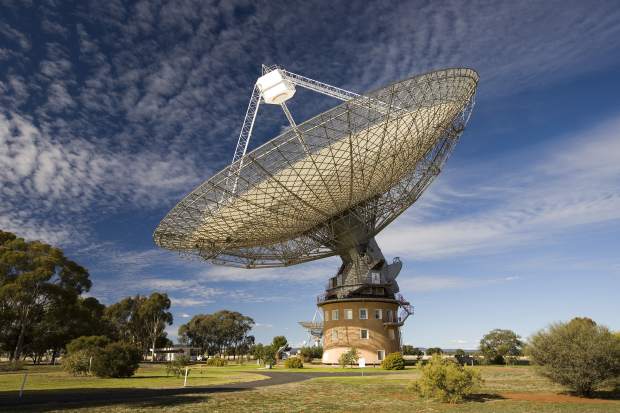
CSIRO’s Parkes radio telescope.
CSIRO’s iconic Parkes radio telescope – fondly known as ‘The Dish’ – will get a new receiver that will significantly increase the amount of sky it can see at any one time, enabling new science and supporting local innovation in the space sector.
Australian Research Council Linkage Infrastructure, Equipment and Facilities (LIEF) grants have been awarded for the development of a new receiver for the Parkes radio telescope and a major upgrade for the Australia Telescope Compact Array near Narrabri in NSW.
Both telescopes are owned and operated by the CSIRO for use by astronomers in Australia and around the world.
A $1.15M LIEF grant will support a $3M project to build a sensitive receiver called a ‘cryoPAF’ for the Parkes radio telescope.
Once complete, the new cryoPAF will sit high above the Parkes telescope’s dish surface and receive radio signals reflected up from the dish.
Its detectors will convert radio signals into electrical ones, which can be combined in different ways so that the telescope ‘looks’ in several different directions at once.
The cryoPAF will be cooled to -253°C to reduce ‘noise’ in its electrical circuits, enhancing the ability to detect weak radio signals from the cosmos at frequencies from 700 MHz to 1.9 GHz.
The grant was led by The University of Western Australia, which will coordinate construction and commissioning of the cryoPAF. CSIRO will design, build and install the instrument.
There are five further research organisations involved in the project.
Professor Lister Staveley-Smith from The University of Western Australia node of ICRAR, who led the grant application, said the cryoPAF has three times more field of view than the previous instrument, allowing quicker and more complete surveys of the sky.
“The new receiver will help astronomers to study fast radio bursts and pulsar stars, and observe hydrogen gas throughout the Universe,” Professor Staveley-Smith said.
A phased-array feed or PAF is a close-packed array of radio detectors.
CSIRO has previously designed and built innovative phased-array feeds for its ASKAP telescope in Western Australia, and a test version of the cryoPAF was used successfully on the Parkes telescope in 2016.
Director of CSIRO Astronomy and Space Science Dr Douglas Bock said that in addition to boosting the capabilities of the Parkes telescope, the cryoPAF receiver technology had the potential to create spin-off opportunities.
“Phased arrays have found extensive use in defence radar, medical imaging and even optical laser beam steering, with emerging applications in satellite communications and telecommunications,” Dr Bock said.
“Their further development at radio wavelengths has technology applications beyond radio astronomy with the potential to fuel the growth of space-related industries here in Australia.”
A second LIEF grant, worth $530,000, will support a $2.6M upgrade of the Australia Telescope Compact Array.
The existing digital signal processor will be replaced with a GPU-powered processor to double the bandwidth of the telescope’s signal electronics.
The project is being led by Professor Ray Norris from Western Sydney University, working closely with CSIRO and seven other university partners.
Professor Norris said the upgrade will enable Australian researchers to address major challenges in our understanding of the Universe, and make more ground-breaking discoveries, across broad areas of astrophysics.
“The upgrade will enable the telescope to study radio counterparts to gravitational wave sources, and it will enable it to make detailed observations of initial discoveries made with the Australian Square Kilometre Array Pathfinder and other Australian telescopes,” Professor Norris said.
CSIRO is a leader in radio astronomy technology development, working in close partnership with astronomers who use its telescopes as well as international observatory customers.
“We’ve been developing specialised instrumentation for radio telescopes since the 1940s, when the field of radio astronomy first emerged, for our own and international telescopes,” Dr Bock said.
“Through our close collaborations with research partners and our expertise in technology development, we’ll keep the telescopes at the cutting edge of science.”







